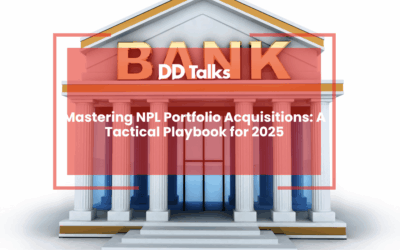Key Takeaways
- Re-performing loans (RPLs) are credit facilities that have resumed regular payments after a period of delinquency, representing approximately €120 billion in value across the EU.
- The transition from non-performing to re-performing status typically involves loan modifications including interest rate reductions, term extensions, or principal adjustments, with 6-12 months of consistent payments required for reclassification.
- RPLs occupy a middle ground in the risk spectrum between non-performing loans (NPLs) and traditional performing loans, offering higher yields but with elevated risk compared to conventional credit.
- Market growth is driven by regulatory pressure, economic recovery, investor demand for yield, and technological advancements in loan servicing and monitoring.
- Successful RPL investment strategies include buy-and-hold approaches, securitization, active management, and rehabilitation with exit strategies, all requiring specialized expertise in underwriting and risk management.
- The future outlook for European RPL markets shows increasing standardization, technological innovation, and broader institutional investor participation as the asset class matures.
Table of Contents
- Understanding Re-Performing Loans: Definition and Market Context
- From Non-Performing to Re-Performing: The Loan Recovery Journey
- Key Differences Between NPLs, RPLs, and Non-QM Loans
- What Factors Are Driving the Growth of Re-Performing Loan Markets?
- Re-Performing Loan Underwriting: Process and Considerations
- Investment Strategies for Re-Performing Loan Portfolios
- Managing Risks in Re-Performing Loan Investments
- Future Outlook: Re-Performing Loans in the Evolving Financial Landscape
Understanding Re-Performing Loans: Definition and Market Context
Re-performing loans (RPLs) represent a significant segment within the European banking landscape that has gained considerable attention in recent years. By definition, re-performing loans are credit facilities that were previously delinquent or in default but have since resumed regular payment patterns for a specified period, typically three to twelve months. These loans occupy a unique position in the credit spectrum, sitting between performing loans and non-performing exposures.
The European RPL market has expanded substantially following the 2008 financial crisis and subsequent European sovereign debt crisis, which left many financial institutions with substantial portfolios of troubled assets. As economic conditions improved and loan modification programmes took effect, a significant portion of non-performing loans (NPLs) transitioned to re-performing status. According to European Banking Authority data, the volume of re-performing loans across the EU has grown to represent approximately €120 billion in value, creating a substantial secondary market for these assets.
For financial institutions, RPLs present both opportunities and challenges. While they generate cash flow and have demonstrated payment recovery, they still carry elevated risk profiles compared to loans that have never experienced delinquency. This unique risk-return profile has attracted specialised investors seeking yield in the low-interest-rate environment that has characterised European markets for much of the past decade.
From Non-Performing to Re-Performing: The Loan Recovery Journey
The transition from non-performing to re-performing status represents a critical journey in the lifecycle of troubled loans. This process typically begins when a loan enters delinquency, defined in the European context as being 90 days past due, at which point it is classified as non-performing according to European Central Bank guidelines. From this point, several pathways can lead to re-performance.
Loan modification programmes serve as the primary mechanism for facilitating this transition. These may include interest rate reductions, term extensions, principal forbearance, or in some cases, principal forgiveness. The European Banking Authority has established frameworks for sustainable restructuring that aim to provide borrowers with manageable payment terms while maximising recovery value for lenders. Special servicing plays a crucial role in this process, with dedicated teams working directly with borrowers to develop customised solutions based on their financial circumstances.
Debt restructuring negotiations often involve detailed financial assessments of borrowers’ capacity to pay, with loss mitigation strategies designed to align payment obligations with realistic income projections. Successful modifications result in resumed payment patterns, though these loans remain under heightened monitoring. After establishing consistent payment history—typically 6-12 consecutive months of timely payments—loans may be reclassified as re-performing.
This recovery journey is not merely administrative but represents a fundamental rehabilitation of the credit relationship. For borrowers, it offers a path to financial recovery and credit repair; for lenders, it transforms non-productive assets into cash-flowing investments. The effectiveness of this transition process significantly influences the performance and valuation of resulting re-performing loan portfolios.
Key Differences Between NPLs, RPLs, and Non-QM Loans
Understanding the distinctions between non-performing loans (NPLs), re-performing loans (RPLs), and non-qualified mortgage (non-QM) loans is essential for navigating the European credit landscape. These three categories represent different risk profiles and investment characteristics that influence their treatment in financial markets.
NPLs are defined by regulatory authorities, including the European Banking Authority, as loans where the borrower is 90 days or more past due on contractual payments or where full repayment is assessed as unlikely without collateral realisation. These loans generate no income, require significant provisioning, and negatively impact capital ratios. In contrast, RPLs have resumed regular payment patterns following a period of delinquency or modification. They generate cash flow but retain elevated risk profiles compared to loans that have never experienced payment interruptions.
Non-QM loans represent a distinct category that doesn’t meet standard underwriting criteria for qualified mortgages but aren’t necessarily impaired. In the European context, these often include self-employed borrowers, those with non-traditional income documentation, or loans with debt-to-income ratios exceeding standard thresholds. While non-QM loans share some characteristics with RPLs, they differ fundamentally in that they may never have experienced delinquency but simply fall outside conventional underwriting parameters.
From a risk assessment perspective, these categories present a spectrum: NPLs carry the highest default risk and lowest immediate value, RPLs offer improved cash flow with moderate risk, and non-QM loans typically present higher yields than conventional loans but with additional underwriting complexity. For investors and financial institutions, recognising these distinctions is crucial for portfolio management, pricing, and regulatory compliance strategies.
What Factors Are Driving the Growth of Re-Performing Loan Markets?
Several interconnected factors have catalysed the expansion of re-performing loan markets across Europe in recent years. Regulatory pressure stands as perhaps the most significant driver, with the European Central Bank’s guidelines on NPL management compelling banks to reduce non-performing exposures. This regulatory framework has incentivised financial institutions to actively pursue loan workouts and modifications that can transition troubled assets to re-performing status rather than pursuing immediate liquidation.
Economic recovery following the European sovereign debt crisis has created favourable conditions for loan rehabilitation. Improved employment rates, wage growth, and property value appreciation have enhanced borrowers’ ability to meet restructured payment obligations. This macroeconomic environment has supported the success of loan modification programmes, resulting in higher conversion rates from non-performing to re-performing status.
The persistent low-yield environment across European fixed-income markets has simultaneously driven investor demand for alternative credit investments offering attractive risk-adjusted returns. Re-performing loans, with their higher yields compared to traditional performing credit, have attracted significant capital from institutional investors, private equity firms, and specialised credit funds seeking exposure to this asset class.
Technological advancements in loan servicing and monitoring have also facilitated market growth by improving the efficiency of managing re-performing portfolios. Sophisticated analytics for default risk assessment and early warning systems have enhanced servicers’ ability to maintain loans in re-performing status through proactive intervention strategies. Additionally, the development of secondary markets for RPLs has improved liquidity and price discovery, further stimulating market activity and investor participation in this growing sector.
Re-Performing Loan Underwriting: Process and Considerations
The underwriting of re-performing loans requires a specialised approach that differs significantly from traditional credit assessment methodologies. When evaluating RPLs, underwriters must conduct a comprehensive analysis that extends beyond standard credit metrics to incorporate the loan’s delinquency history, modification terms, and post-modification performance patterns.
The process typically begins with a detailed review of the loan’s performance timeline, identifying the duration and severity of previous delinquency, as well as the specific circumstances that led to payment interruption. Underwriters then analyse the effectiveness of any modification programmes implemented, evaluating whether the restructured terms have created a sustainable payment structure aligned with the borrower’s financial capacity. This assessment includes scrutinising the borrower’s current income stability, debt service coverage ratios, and overall financial resilience.
Collateral valuation plays a particularly critical role in RPL underwriting, with emphasis on current market value assessments and forward-looking projections that account for regional economic trends. Loan-to-value ratios are typically calculated using conservative valuation methodologies that reflect the elevated risk profile of previously troubled assets. For residential mortgages, factors such as property condition, location stability, and liquidity characteristics significantly influence underwriting decisions.
Regulatory compliance considerations add another layer of complexity to the RPL underwriting process. Underwriters must ensure adherence to consumer protection regulations, particularly those governing loan modifications and collections practices. Documentation standards for RPLs are typically more rigorous than for conventional loans, requiring comprehensive evidence of the borrower’s recovery journey and current financial status. These specialised underwriting approaches help financial institutions and investors accurately assess the risk-return profile of re-performing loan opportunities.
Investment Strategies for Re-Performing Loan Portfolios
Investors approaching the re-performing loan market can employ several distinct strategies, each offering different risk-return profiles and operational requirements. Buy-and-hold strategies represent the most straightforward approach, where investors acquire RPL portfolios to capture the spread between acquisition price (typically at a discount to par value) and the income generated through regular payments. This strategy requires patience and typically appeals to institutional investors with longer investment horizons, such as pension funds and insurance companies seeking stable, above-market yields.
Securitisation has emerged as a sophisticated strategy for RPL investors, particularly in more developed markets like the UK, Spain, and Italy. By pooling re-performing loans and creating structured securities with different risk tranches, investors can tailor their exposure to match specific risk appetites. Senior tranches offer lower yields but greater protection against default risk, while subordinated tranches provide higher returns with corresponding risk levels. This approach has gained traction as European securitisation markets have matured and investor comfort with RPL performance characteristics has increased.
Active management strategies focus on enhancing portfolio performance through specialised servicing and borrower engagement. Investors employing this approach typically work with dedicated special servicers who implement proactive communication programmes, early intervention for payment issues, and customised solutions for borrowers experiencing renewed financial stress. The objective is to minimise redefault rates and maximise the proportion of loans that continue performing or eventually return to full performing status.
Rehabilitation and exit strategies involve acquiring RPLs with the intention of improving their performance metrics through active management, then selling them at higher valuations once they demonstrate sustained performance. This approach requires sophisticated operational capabilities and market timing expertise but can generate attractive returns through both yield and capital appreciation. Regardless of strategy selection, successful RPL investing demands specialised expertise in credit assessment, servicing oversight, and regulatory compliance.
Managing Risks in Re-Performing Loan Investments
Re-performing loan investments present a unique risk profile that requires sophisticated management approaches. Redefault risk stands as the primary concern, with historical data indicating that previously modified loans exhibit higher probabilities of returning to delinquency compared to loans that have never experienced payment interruptions. To mitigate this risk, investors implement robust monitoring systems that track payment patterns and identify early warning indicators of potential distress, enabling proactive intervention before formal delinquency occurs.
Servicing quality represents another critical risk factor in RPL portfolio management. The specialised nature of re-performing loan servicing means that servicer selection and oversight become fundamental components of risk management. Investors typically establish detailed servicing agreements with performance metrics, incentive structures aligned with portfolio outcomes, and rigorous reporting requirements. Regular servicer audits and performance reviews help ensure adherence to established protocols and regulatory requirements.
Regulatory compliance risks have intensified as European authorities have strengthened consumer protection frameworks governing debt collection, loan modification, and borrower communication practices. Investors must navigate complex and sometimes divergent regulatory environments across different European jurisdictions, necessitating comprehensive compliance management systems and legal expertise specific to each market where they operate.
Market liquidity risk affects RPL investments, particularly during periods of financial stress when secondary market activity may diminish. This risk can be managed through diversification across loan types, geographical regions, and vintage years, as well as through structured exit strategies that don’t rely on immediate market liquidity. Additionally, interest rate risk requires careful consideration, as RPL portfolios often include modified loans with interest rate structures that may respond differently to market rate movements compared to conventional performing loans. Sophisticated hedging strategies and stress testing under various interest rate scenarios form essential components of comprehensive RPL risk management frameworks.
Future Outlook: Re-Performing Loans in the Evolving Financial Landscape
The European re-performing loan market stands at an inflection point, with several emerging trends likely to shape its evolution in the coming years. Technological innovation represents a transformative force, with advanced analytics and artificial intelligence increasingly deployed to enhance predictive modelling of RPL performance. These technologies enable more precise risk assessment, allowing for more accurate pricing and potentially expanding the investor base for these assets. Blockchain applications are also being explored for improving transparency and efficiency in RPL transactions, potentially reducing due diligence costs and accelerating settlement processes.
Regulatory developments continue to influence market dynamics, with the European Banking Authority’s ongoing refinement of NPL management guidelines indirectly affecting the RPL ecosystem. The implementation of the EU Action Plan on non-performing loans has accelerated the resolution of troubled assets, creating a pipeline of potential re-performing exposures. Simultaneously, heightened focus on consumer protection and responsible lending practices is reshaping modification programmes and servicing protocols, potentially improving long-term sustainability of loan workouts.
Market maturation is evident in the increasing standardisation of RPL documentation, servicing practices, and performance metrics across European markets. This standardisation is facilitating greater cross-border investment activity and improving liquidity in secondary markets. Institutional investor participation continues to expand beyond specialised distressed debt funds to include more mainstream asset managers seeking yield enhancement in the persistent low-interest-rate environment.
Looking forward, the re-performing loan sector is likely to experience continued growth while becoming more integrated into mainstream financial markets. As data history on RPL performance lengthens, risk models will become more refined, potentially reducing risk premiums and improving financing options for these assets. The sector’s evolution represents a positive development for European financial markets, providing mechanisms for rehabilitating troubled credits while offering investors access to an asset class with distinctive risk-return characteristics. Financial institutions that develop expertise in this specialised market segment will be well-positioned to capitalise on opportunities while contributing to the overall resilience of the European banking system.
Frequently Asked Questions
What is a re-performing loan?
A re-performing loan (RPL) is a credit facility that was previously delinquent or in default but has since resumed regular payment patterns for a specified period, typically three to twelve months. These loans occupy a middle position in the credit spectrum between performing loans and non-performing exposures, generating cash flow while still carrying elevated risk profiles compared to loans that have never experienced delinquency.
How do non-performing loans become re-performing?
Non-performing loans transition to re-performing status through loan modification programs that may include interest rate reductions, term extensions, principal forbearance, or principal forgiveness. This process involves special servicing teams working directly with borrowers to develop customized solutions based on their financial circumstances. After establishing consistent payment history—typically 6-12 consecutive months of timely payments—loans may be reclassified as re-performing.
What’s the difference between RPLs, NPLs, and Non-QM loans?
NPLs (non-performing loans) are 90+ days past due with no income generation. RPLs (re-performing loans) have resumed payments after modification following delinquency. Non-QM loans don’t meet standard underwriting criteria but aren’t necessarily impaired—they include loans to self-employed borrowers or those with non-traditional income documentation. Each category represents different risk profiles: NPLs carry the highest default risk, RPLs offer improved cash flow with moderate risk, and non-QM loans present higher yields than conventional loans with additional underwriting complexity.
What factors are driving growth in the re-performing loan market?
The RPL market growth is driven by regulatory pressure from the ECB compelling banks to reduce non-performing exposures, economic recovery improving borrowers’ ability to meet restructured obligations, low-yield environments creating investor demand for higher-yielding alternative credit investments, technological advancements in loan servicing, and the development of secondary markets improving liquidity and price discovery for these assets.
How are re-performing loans underwritten?
Re-performing loan underwriting involves analyzing the loan’s delinquency history, modification terms, and post-modification performance patterns. Underwriters review the loan’s performance timeline, evaluate modification effectiveness, assess the borrower’s current financial stability, conduct conservative collateral valuation, and ensure regulatory compliance. This specialized approach requires more rigorous documentation standards than conventional loans to accurately assess the risk-return profile of previously troubled assets.
What are the main investment strategies for re-performing loan portfolios?
The main investment strategies for RPL portfolios include: buy-and-hold approaches capturing the spread between discounted acquisition price and regular payment income; securitization creating structured securities with different risk tranches; active management focusing on specialized servicing to minimize redefault rates; and rehabilitation strategies involving improving performance metrics through management before selling at higher valuations. Each strategy offers different risk-return profiles requiring specialized expertise in credit assessment and servicing oversight.
What are the primary risks when investing in re-performing loans?
Primary risks in RPL investments include redefault risk (previously modified loans showing higher probabilities of returning to delinquency), servicing quality risk (requiring specialized servicing expertise), regulatory compliance risks (navigating complex consumer protection frameworks), market liquidity risk (potentially limited secondary market activity during financial stress), and interest rate risk (modified loans responding differently to market rate movements). These risks require sophisticated management approaches including robust monitoring systems, careful servicer selection, comprehensive compliance frameworks, portfolio diversification, and stress testing.




0 Comments